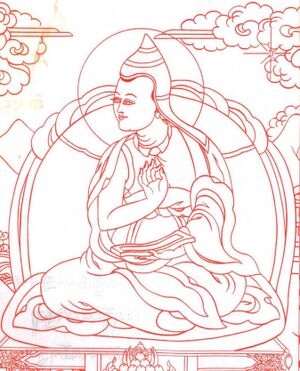Getse Paṇḍita's Presentation of Great Middle Way[edit]
Getse Mahāpaṇḍita Tsewang Chokdrup composed his short work entitled Ornament of Sugatagarbha: A Discourse Ascertaining the Definite Great Middle Way (ངེས་དོན་དབུ་མ་ཆེན་པོའི་ཚུལ་རྣམ་པར་ངེས་པའི་གཏམ་བདེ་གཤེགས་སྙིང་པོའི་རྒྱན།), as he would put, as a mere key which can unlock the door of sūtras and tantras (ལྡེ་མིག་ཙམ་འདིས་མདོ་སྔགས་སྒོ་ཕྱེ་). He structures his short work by aligning the four Buddhist tenet systems to the three sets of turnings of the wheel of Dharma. The first two tenet systems of Vaibhāṣika and Sautrāntika, which espouse the ultimate existence of atomic particles and moments of consciousness as building blocks for the empirical world, correspond to the first turning of the wheel, while the third tenet system, the Cittamātra system of idealist thinkers, who assert the true existence of an innate self-cognizing mind, is based on some sūtras of the last turning of the wheel.
These schools were overshadowed by the rise of the Middle Way tradition, which was promoted by Nāgārjuna and his followers based on the Perfection of Wisdom sūtras of the middle turning. Getse recounts the development of the Mādhyamika school and its bifurcation into Svātantrika and Prāsaṅgika subschools among Nāgārjuna's followers, who for some reason also considered Asaṅga's tradition to be the Cittamātra tradition, thereby leading many biased scholars of India and Tibet to classify Asaṅga and his followers as Cittamātra masters. Getse rejects that the ultimate understanding of Asaṅga and his followers is of Cittamātra thought.
Furthermore, the Middle Way tradition focusing on the emptiness of all phenomena as primarily shown in the middle turning, based on rational analysis to eliminate ordinary superimposition of self and other characteristics, and passed down through Nāgārjuna’s followers, according to Getse Mahāpaṇḍita, is only the coarse, outer Middle Way (རགས་པ་ཕྱིའི་དབུ་མ་). The inner, subtle Middle Way (ཕྲ་བ་ནང་གི་དབུ་མ་) is what is taught in the last turning through the tathāgatagarbhasūtras, the innate self-awareness, buddha-nature, or element, which is also elucidated in the works of Maitreya and passed down through Nāgārjuna, Asaṅga, and their followers as the ultimate and quintessential message. This, Getse Mahāpaṇḍita calls the Great Madhyamaka of other-emptiness (གཞན་སྟོན་དབུ་མ་ཆེན་པོ་) and the ultimate truth, the luminous nature of the mind, the adamantine mind, and the main point of Kālacakra, Mahāmudrā, and Dzogchen teachings. A mere emptiness that is a nonimplicative negation is not the ultimate reality. The ultimate intent of the great masters converges on this point of innate luminous awareness, although they showed different types of provisional paths. The short work of Getse Mahāpaṇḍita is aimed at establishing the Great Middle Way or other-emptiness as the ultimate and absolute reality which forms the basis of saṃsāra and nirvāṇa, and he does so with great precision and vigor in a short work.
Weekly quote[edit]
~

